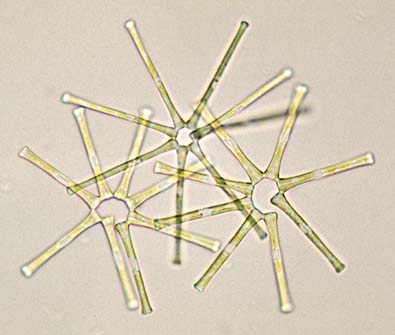Plankton - the Primary Producers of the Aquatic World
Lesson Introduction

Plankton are the bottom of the food chain in aquatic systems. Without them, there would be no life in lakes, ponds, or oceans. In simple terms, phytoplankton are the primary producers or microscopic plant life of an aquatic system while zooplankton, next up the on the chain, are their consumers. The word plankton refers to the greek word "planktos" meaning"drifter". Most plankton lack the ability to swim, they free-float in aquatic systems at the mercy of the tides, waves, and currents. However, many plankton have unusual symmetry or adaptations which allows them to avoid predation, float without sinking deeper into the water column where there is less sunlight, and provide some mobility. Dinoflagellates for example have a two flagellae or tails that gives them limited mobility in the water.
Being primary producers in the aquatic world, phytoplankton rely on light for their energy. They gather energy from sunlight, convert this energy into carbohydrates and release oxygen. They also need nutirents. Just like terrestrial plants that take nutrients from the soil, phytoplankton absorb nutrients from the water column through their cell walls. Nitrogen and phosphorous are the primary nutrients taken up by phytoplankton, although many more are used by these organisms. Phosphorous is the primary nutrient that limits plant growth in aquatic systems while Nitrogen is the primary nutrient that limits terrestrial plant growth.
Like terrestrial plants, phytoplankton play a major role in oxygen production. During the day, while they are photosynthesizing, the phytoplankton give off oxygen, and during the night, while they are respiring, they use up oxygen.
Formulas for Photosynthesis and Respiration:
Photosynthesis: 6CO2 + Esun + 6 H2O 6O2 + C6 H12O6
Respiration: 6O2 + C6 H12 O6 6 CO2 + Ecells + 6 H2O
In healthy aquatic systems the amount of oxygen produced during the day by phytoplankton compensates for the oxygen lost during the night when they are not photosynthesiszing. This cycle may become disruptive if respiration processes take up too much oxygen - causing stress to other aquatic organisms. Oxygen depletion can take place in lakes or ponds that are considered eutrophic - or overly-productive and nutrient rich. Scientists determine the rates of photosynthesis and respiration in aquatic systems to see if they are in equilibrium. One way to do this is to measure the rates of oxygen production and oxygen consumption in a sample of water from the lake or pond you are studying. Through calculations you can then determine the net productivity of oxygen in a system.
Activities
Activity 1 - Measuring Primary Productivity
Activity 2 - How does fertilizers such as phosphorous effect phytoplankton growth?
